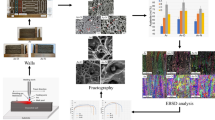Abstract
Joints combining dissimilar metals and alloys are essential parts of domestic devices and heat-exchange systems. One of the greatest challenges is to develop and implement fast and cost-effective industrial procedures to join aluminium with copper, titanium, or stainless steel. Regardless of the process conditions, such exotic metal combinations cannot be fusion welded autogenously because of the formation of highly brittle microstructures. Of all “cold-joining” processes, electromagnetic welding may offer the utmost potential for fabricating bimetallic components. The process is straightforward and mechanistically comparable to explosive bonding, except that it safely uses intense magnetic fields to collide two axis-symmetrical parts into each other. In this paper, the microstructures at interfaces of electromagnetic welds between aluminium and other metals or alloys are discussed. By carefully selecting the process conditions, microstructures and properties of weld joints (mechanical, electrical, etc.) can be controlled. Mechanical interlocking as well as thin and discontinuous intermetallic phases (all resulting from localized melting) will control the final properties of electromagnetic welds between dissimilar materials.
Similar content being viewed by others
References
Sun Z., Karpi R.: The application of electron beam welding for the joining of dissimilar metals, An overview, Journal of Materials Processing Technology, 1996, No. 59, pp. 257–267.
Marya M., Liu S.: The search for a filler metal for the dissimilar metal joining of iron-to-titanium, Science and Technology of Welding and Joining, 2001, Vol. 6, No. 4, pp. 240–246.
Baker H., Okamoto H.: ASM Handbook Volume 03, Alloy Phase Diagrams (American Society for Materials), 1992.
Murakami T., Nakata K., Tong H., Ushio M.: Dissimilar metal joining of steel to aluminium by lap joint MIG arc brazing, Transactions of the JWRI, 2003, Vol. 32, No. 1, pp. 35–37.
Radscheit C., Schubert E., Sepold G., Laser beam brazing — A bonding technique for combinations of different materials (Laserstrahlhartloten — ein geeignetes Fugeverfahren), Proceedings of 4th International Conference on High Temperature Brazing and Diffusion Welding, Aachen, June 27–29 1995.
Rathod M.J., Kutsuna M., Joining of aluminium alloy 5052 and low-carbon steel by laser roll welding, Welding Journal, 2004, Vol. 83, No. 1, pp. 16s–26s.
Shribman V., Livshitz Y., Gafri O.: The magnetic pulse welding process, Proceedings 3rd International Workshop on Joining of Aerospace Materials, Bokenas, Sweden, 12–14 Sept. 2000.
Shribman V., Stern A., Livshift V., Gafri O.: Magnetic pulse welding produces high-strength aluminium welds, Welding Journal, 2002, Vol. 84, No. 1, pp. 33–37.
Marya M., Priem D., Marya S.: Microstructures at aluminium-copper magnetic pulse weld interfaces, Proceeding of THERMEC 2003: International Conference on Processing and Manufacturing of Advanced Materials, Madrid, Spain, July 7–11 2003.
Sano T., Takahashi M., Murakoshi Y., Terasaki M., Matuno K.I.: Electromagnetic joining of metal tubes to ceramic rods, Journal of the Japanese Society of Technology and Plastics, 1987, Vol. 28, No. 322, pp. 1193–1198.
Khrenov K.K., Chudakov V.A.: The formation of welded joints in the magnetic pulsed welding of cylindrical work-pieces, Welding Production (USSR), 1978, Vol. 25, No. 9, pp. 19–20.
Khrenov K.K., Chudakov V.A.: Obtaining welded joints by pulsed-magnetic welding of cylindrical components, Svar. Proizvod, 1978, No. 9, pp. 13–14.
Brown W.F., Bandas J., Olson N.T.: Pulsed magnetic welding of breeder reactor fuel pin end closures, Welding Journal, 1978, Vol. 57, No. 6, pp. 22–26.
ASM Handbook Volume 06, Welding, Brazing and Soldering (American Society for Materials), 1993.
Trueb L.F.: Electron-microscope study of thermal recovery processes in explosion-shocked nickel, Journal of Applied Physics, 1968, 40(7), pp. 2976–2987.
Markashova L.I., Sergeeva Y.U.A., Statsenko V.V., Chudakov V.A.: Special features of the mechanism of structure formation in magnetic pulsed welding, Paton Welding Journal, 1991, Vol. 3, No. 3, pp. 187–191.
Stern A., Aizenshtein M.: Bonding zone formation in magnetic pulse welds, Science & Technology of Welding and Joining, 2002, Vol. 7, No. 5, pp. 339–342.
Epechurin V.P.: Properties of bimetal joints produced by magnetic-pulse welding, Svar. Proiz, 1974, Vol.5, pp. 12–14.
Onosovskii E.V., Chudakov V.A., Sokolov V.I., Saprygin V.D.: Magnetic pulse welding of thin-walled aluminium-steel adapters, Kim. Neft. Mashinostr., 1984, No. 11, pp. 25–26.
Karakozov E.S., Chankvetadze Z.A., Beriev N.M.: The interaction of metals in magnetic impulse welding, Svar. Proiz, 1977, Vol. 12, pp. 4–6.
Strizhakov Y.: Calculating and selecting the parameters of magnetic pulsed vacuum welding, Physics and Chemistry of Materials Technology, 1991, Vol. 5, No. 1, pp. 89–91.
Rice P., Stoller R.: Correlation of Nanoindentation and conventional mechanical property measurements, Proceedings of Symposium on Fundamentals of Nanoindentation and Nanotribology II, Fall MRS Meeting, 2002.
Author information
Authors and Affiliations
Rights and permissions
About this article
Cite this article
Marya, M., Marya, S. & Priem, D. On The Characteristics of Electromagnetic Welds Between Aluminium and other Metals and Alloys. Weld World 49, 74–84 (2005). https://doi.org/10.1007/BF03263412
Published:
Issue Date:
DOI: https://doi.org/10.1007/BF03263412




